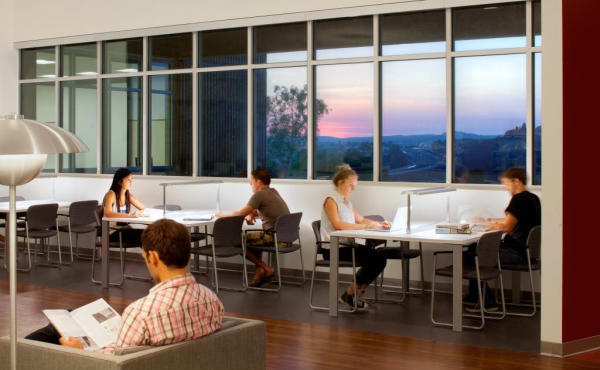
Like so many other things - TV listings, flights, trains and appointments - your body operates on a clock. Experiencing that sluggish feeling after jet lag and Daylight Savings Time happens for a reason, and it all has to do with our circadian rhythm.
Saddleback College Library, Mission Viejo, CA | Architecture: gkkworks | Lighting Design: First Circle Design | Lighting: Vode System table-mounted WingRail | Image: Lawrence Anderson Photography.
Lighting: The Hidden Key Behind Circadian Rhythm
It's easy to assume that the change in time is responsible for internal clocks, but science tells us that it has much more to do with your exposure to light and the environment around you. We have instances during the day when we feel a bit tired, and others when our energy levels couldn't be more strong. According to the American Lighting Association, this isn't just because of a coffee crash or staying up too late the night before - your internal clock is impacted by your exposure to light more than any other factor.
Do you ever wonder why it is always so tough to get out of bed once winter rolls around? You might assume it's because you want to shield yourself under the covers because of the frightful weather, but in actuality, the lack of daylight is what is most responsible for your body wanting those extra zzz's. This also could explain the phenomenon of the "winter blues," since some of us can go for days or even weeks without seeing the sun. Waking up and feeling chipper when it is still dark outside just doesn't feel natural - and your body knows it.
"Studies have shown that light affects sleep habits, depression and mental functions," Terry McGowan, FIES, LC, director of engineering and technology for American Lighting Association and owner of Cleveland, Ohio-based Lighting Ideas, explained. "The term 'healthy lighting' has been used to indicate that light can act like a drug where the strength, timing and type of light can be used to alleviate problems and enhance well-being. The 'prescription' is simple: People need bright days and dark nights that match the natural day/night circadian cycle."
Practical Solutions for Lighting Designers to Emulate Circadian Rhythm
So how do lighting designers positively impact health and wellness with their fixtures? Although solutions may be tough, it is one of the biggest challenges that those in the lighting and architectural industries face.
Buildings from the past, especially large-scale structures and offices, have implemented windows that are too small, and some may have only one or two per floor. This means that workers and employees may not see daylight at all during some seasons, which can have a direct impact on workflow, mental function and overall wellness.
Although lighting and architecture may have not worked with these issues in mind in the past, times are changing. Open offices and buildings with large windows and minimalist design are now allowing natural and artificial light to work together so that people can be exposed to the lighting that they need to have their circadian rhythm function at optimal levels.
The Washington Post highlighted a book authored by Michael Terman and Ian McMahan in 2013 entitled "Chronotherapy: Resetting Your Inner Clock to Boost Mood, Alertness and Quality Sleep." This writing explained the relationship between balanced indoor lighting fixtures, architecture, exposure to the sun, and the way that all of these factors play into human health and circadian cycle.
Modern architecture has made great strides in the past few decades to allow fixtures to "hide" and let the sunshine in, but there is more that can be done. The book explained the fact that depending on age and other factors, every individual's circadian cycle is different, so the need for efficient and flexible lighting design options - such as tunable lighting - could be a positive impact on lighting and health moving forward.
Subscribe and stay up to date
receive essential emails.






Speak Your Mind